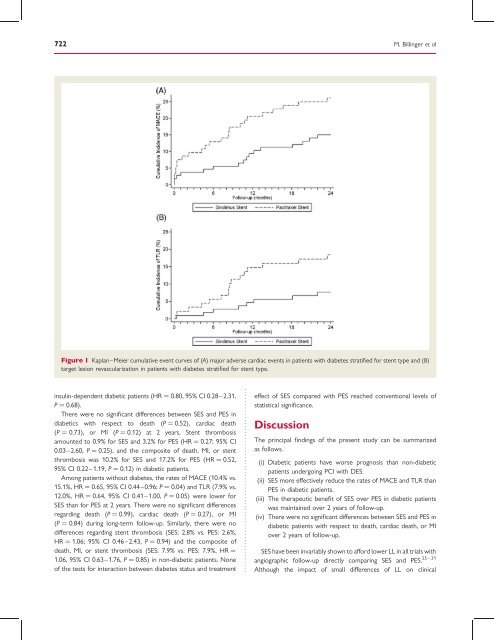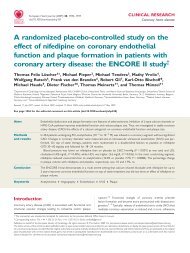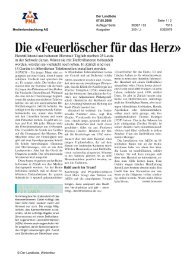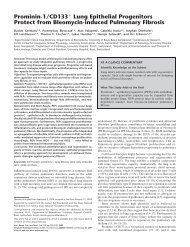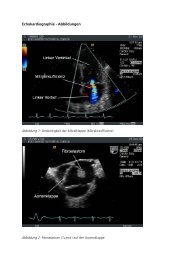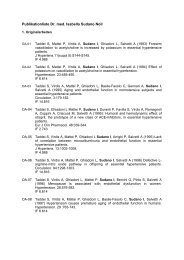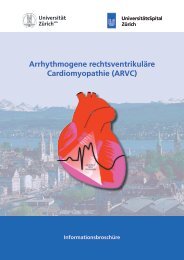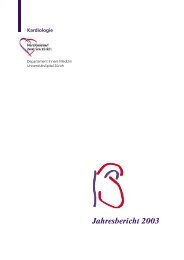Two-year clinical outcome after implantation of sirolimus-eluting and ...
Two-year clinical outcome after implantation of sirolimus-eluting and ...
Two-year clinical outcome after implantation of sirolimus-eluting and ...
Create successful ePaper yourself
Turn your PDF publications into a flip-book with our unique Google optimized e-Paper software.
722<br />
M. Billinger et al<br />
Figure 1 Kaplan–Meier cumulative event curves <strong>of</strong> (A) major adverse cardiac events in patients with diabetes stratified for stent type <strong>and</strong> (B)<br />
target lesion revascularization in patients with diabetes stratified for stent type.<br />
insulin-dependent diabetic patients (HR ¼ 0.80, 95% CI 0.28–2.31,<br />
P ¼ 0.68).<br />
There were no significant differences between SES <strong>and</strong> PES in<br />
diabetics with respect to death (P ¼ 0.52), cardiac death<br />
(P ¼ 0.73), or MI (P ¼ 0.12) at 2 <strong>year</strong>s. Stent thrombosis<br />
amounted to 0.9% for SES <strong>and</strong> 3.2% for PES (HR ¼ 0.27; 95% CI<br />
0.03–2.60, P ¼ 0.25), <strong>and</strong> the composite <strong>of</strong> death, MI, or stent<br />
thrombosis was 10.2% for SES <strong>and</strong> 17.2% for PES (HR ¼ 0.52,<br />
95% CI 0.22–1.19, P ¼ 0.12) in diabetic patients.<br />
Among patients without diabetes, the rates <strong>of</strong> MACE (10.4% vs.<br />
15.1%, HR ¼ 0.65, 95% CI 0.44–0.96; P ¼ 0.04) <strong>and</strong> TLR (7.9% vs.<br />
12.0%, HR ¼ 0.64, 95% CI 0.41–1.00, P ¼ 0.05) were lower for<br />
SES than for PES at 2 <strong>year</strong>s. There were no significant differences<br />
regarding death (P ¼ 0.99), cardiac death (P ¼ 0.27), or MI<br />
(P ¼ 0.84) during long-term follow-up. Similarly, there were no<br />
differences regarding stent thrombosis (SES: 2.8% vs. PES: 2.6%,<br />
HR ¼ 1.06; 95% CI 0.46–2.43, P ¼ 0.94) <strong>and</strong> the composite <strong>of</strong><br />
death, MI, or stent thrombosis (SES: 7.9% vs. PES: 7.9%, HR ¼<br />
1.06, 95% CI 0.63–1.76, P ¼ 0.85) in non-diabetic patients. None<br />
<strong>of</strong> the tests for interaction between diabetes status <strong>and</strong> treatment<br />
effect <strong>of</strong> SES compared with PES reached conventional levels <strong>of</strong><br />
statistical significance.<br />
Discussion<br />
The principal findings <strong>of</strong> the present study can be summarized<br />
as follows.<br />
(i) Diabetic patients have worse prognosis than non-diabetic<br />
patients undergoing PCI with DES.<br />
(ii) SES more effectively reduce the rates <strong>of</strong> MACE <strong>and</strong> TLR than<br />
PES in diabetic patients.<br />
(iii) The therapeutic benefit <strong>of</strong> SES over PES in diabetic patients<br />
was maintained over 2 <strong>year</strong>s <strong>of</strong> follow-up.<br />
(iv) There were no significant differences between SES <strong>and</strong> PES in<br />
diabetic patients with respect to death, cardiac death, or MI<br />
over 2 <strong>year</strong>s <strong>of</strong> follow-up.<br />
SES have been invariably shown to afford lower LL in all trials with<br />
25 – 31<br />
angiographic follow-up directly comparing SES <strong>and</strong> PES.<br />
Although the impact <strong>of</strong> small differences <strong>of</strong> LL on <strong>clinical</strong>


